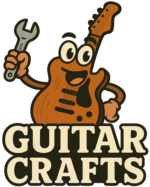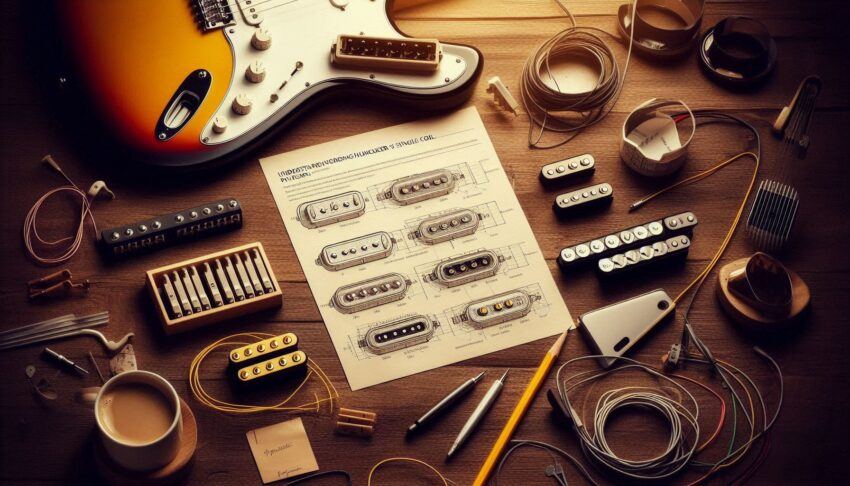Upgrading pickups and electronics in guitar kits can take your tone and playing experience to a whole new level. Whether you’re working with a budget DIY kit or you’re just looking to squeeze more personality out of your favorite instrument, swapping pickups and electronics is a pretty solid place to start. There are tons of choices and techniques out there, so I’ve put together the Ultimate Guide To Upgrading Pickups And Electronics In Guitar Kits, based on real experience, to help you make sense of everything and get your guitar sounding fantastic.
Basics of Guitar Pickups and Electronics
Pickups are the heart of your electric guitar’s sound. These little magnets turn your string vibrations into electrical signals that your amp can transform into music. Most guitar kits ship with entrylevel pickups and simple electronics. The stock options get the job done, but there’s usually a lot of room to make things better.
When people talk about “upgrading electronics,” they usually mean swapping out things like the volume and tone pots (short for potentiometers), selector switches, wiring, and sometimes the output jack. All these parts impact the way your guitar feels and sounds, so they’re worth paying attention to, even if they seem small.
Key Questions to Ask When Planning a Guitar Upgrade
Before spending money on pickups or wiring harnesses, I always run through a short checklist:
- What style of music do I want to play? Some pickups are made for crunchy metal tones, while others keep things cleaner and brighter for jazz or classic rock.
- What do I like or dislike about my current guitar’s sound? It helps to know what you want to change specifically; that could be more sustain, less noise, or sweeter highend.
- How much am I comfortable spending? Upgrades can get expensive, especially with big names, but there are lots of good aftermarket choices at every budget.
- Am I willing to do the work myself, or do I need a tech? Some upgrades require a soldering iron and some basic tools. If you’re not comfortable with that, it’s worth finding a guitar tech who can handle it.
- Are the pickups I’m interested in the right fit for my kit? Not all pickups fit every guitar, so check dimensions and compatibility, especially with different pickup types like singlecoils or humbuckers.
Asking yourself these questions saves money and frustration. It’s a good way to set realistic expectations for your project.
** Here’s a little transparency: Our website contains affiliate links. This means if you click and make a purchase, we may receive a small commission. Don’t worry, there’s no extra cost to you. It’s a simple way you can support our mission to bring you quality content.**
As an Amazon Associate, I earn from qualifying purchases.
What You’ll Need to Change Guitar Pickups and Electronics
I remember the first time I opened up a guitar to swap pickups. I thought all I’d need was the new pickups, but there’s a bit more to it if you want a smooth install. Here’s a list of the basics you’ll want to have:
- Phillips and flathead screwdrivers (for pickguards or pickup rings)
- A soldering iron and solder (unless you buy solderless systems)
- Wire cutters and small pliers
- New electronics if you’re going all in; pots (volume/tone), capacitors, and output jack
- Shielding tape or paint if your guitar is noisy (not required but helpful)
- An electronic multimeter (for troubleshooting, if needed)
Most guitar kits use fairly standard wiring schemes, so you can follow diagrams from pickup makers like Seymour Duncan or Dimarzio for solid results. Take photos before you disconnect anything; this has saved me more than once!
Is It Worth Upgrading Guitar Electronics?
This is one of those topics I get asked a lot. In my experience, upgrading electronics only makes sense if you actually notice a problem or feel like something is lacking. Cheap pots can get scratchy and cut out randomly after a while. Lowquality wiring is more likely to pick up buzz and hum. Budget selector switches can break. Even the output jack, if it’s loose, can make your guitar cut out.
When I swapped my first full wiring harness for quality pots and a reliable switch, I suddenly had smooth volume sweeps and no more static noise. It made the whole guitar feel more responsive. For gigging or studio play, this stuff is super important. Even for playing at home, you’ll hear the difference every day. So, replacing the electronics can absolutely be a smart upgrade, even if you never change your pickups.
How To Choose the Right Pickups for Your Guitar Kit
There are a ton of pickup models and brands available, and it’s easy to get decision fatigue. Here’s how I usually narrow it down:
- Body wood and construction: Lighter woods (like basswood) can sound brighter; heavier bodies (like mahogany) are a bit darker. Some pickups will complement the wood’s natural tone better than others.
- Singlecoil vs. humbucker: Singlecoils are crisp and clear, but humbuckers cut noise and can offer more punch. Many kits let you go either way with the right routing.
- Output: Higheroutput pickups (“hot” pickups) push your amp harder for aggressive rock or metal. Loweroutput pickups preserve clarity for blues, jazz, and funk.
- Famous pickup models: Some brands are classics for a reason. The Seymour Duncan JB and Jazz set, for instance, is super popular with modders.
- Budget: Some import brands are surprisingly good for the price, and you don’t have to spend a fortune to sound great.
Don’t overlook used options; you can score highquality pickups on Reverb or eBay for less than buying new.
Tips for Improving Your Guitar Pickups
Sometimes, you can make even stock or budget pickups sound better with a few low-cost tweaks before upgrading them. Here’s what I’ve tried and found helpful:
- Raise or lower your pickups: Adjusting pickup height can seriously change the way your guitar responds. Closer to the strings gets you more output and a thicker tone. Lower it for more clarity, especially if things sound muddy.
- Pot and cap upgrades: Sometimes just upgrading to better volume or tone pots (and switching the tone cap value) can noticeably change your sound. Vintagestyle paperinoil or orange drop capacitors are worth checking out for smoother tone sweeps.
- Shielding your cavities: Adding copper tape or conductive paint to your control cavity and pickup routes can cut hum and noise, especially for singlecoils.
If those tweaks aren’t enough, it might be time for new pickups altogether.
Step-by-Step: How to Replace Pickups and Electronics
When you’re ready to get into it, here’s a basic roadmap I use when swapping pickups and electronics in a kit:
- Remove the strings and unscrew the pickguard or control plate (if your guitar has one).
- Take clear photos of the existing wiring, especially if this is your first time.
- Desolder or unplug the old pickups and wires from pots and switches.
- Drop in the new pickups. Make sure the screw holes match; sometimes you’ll need to drill new holes if the pickup mounting style is different.
- Wire everything up using a clear wiring diagram. Replacing pots, switch, and output jack at the same time keeps things easy, but you can upgrade one piece at a time if you want.
- Solder all connections securely. Doublecheck that you haven’t left any stray wires touching the wrong spots.
- Tidy up the wiring, then screw everything back together. Restring the guitar and tune it up.
- Test your controls and new pickups; listen for any unwanted buzz or scratchiness when you move the knobs or switch positions.
This process usually takes me an afternoon, even if I’m going slow. If anything doesn’t work right, check for cold solder joints or loose wires first; those are the most common problems.
Common Problems and How to Avoid Them
There are a few hiccups almost everyone runs into. Here are some issues I’ve seen and how to dodge them:
- Microphonic squeal: Sometimes pickups, especially budget ones, can squeal loudly. Wax potting them can help, but swapping for higherquality pickups is the most reliable fix.
- Wiring confusion: Doublecheck the color codes for each brand of pickup. Not every company uses the same colors for “hot” and ground wires.
- Noise and hum: Ground everything to a single point, protect wiring from touching shielding, and use shielded cable for really quiet setups.
If you run into problems you can’t fix, online forums and YouTube tutorials are packed with helpful guides, often walking through the exact kit or pickup model you’re working with.
Frequently Asked Questions
What questions should I ask when purchasing a guitar?
Consider your music style, neck shape preference, preferred body type (solid, semihollow, or hollow), and whether the electronics and pickups suit your goals. Budget and comfort with DIY mods are also worth thinking about.
What do I need to change guitar pickups?
You’ll need a soldering iron, screwdrivers, pliers, wire cutters, and possibly new pots or switches. Some kits offer solderless swaps if you’re not into soldering.
Is it worth upgrading guitar electronics?
For better reliability, smoother performance, and improved tone shaping, it’s definitely worth it, especially if your kit has noisy or flimsy stock components.
How to improve your guitar pickups?
Adjust pickup height for best tone, upgrade pots and capacitors, and use copper shielding to cut hum. If that doesn’t get the sound you want, swapping them out for new pickups is a pretty direct way to change your guitar’s voice.
Wrapping Up: Thoughts on Guitar Kit Upgrades
Upgrading pickups and electronics is a really effective (and fun) way to personalize a guitar kit. With the right parts and a little patience, you’ll stumble upon a whole new side to your instrument. The skills you pick up doing your own mods come in handy again and again as your tastes or gear collection grow. Keep experimenting and enjoy the process; there’s always something new to learn with guitars. And if you ever feel stuck, check out local guitar communities or online groups—there’s a world of other builders out there ready to share wisdom and tips.
There are 100’s of ways you can build a business around your passion for guitar building.
Check it out…



I really enjoyed reading through this—your guide strikes a perfect balance between technical depth and friendly guidance. The way you walk readers through the essentials—understanding pickups and basic electronics, clarifying tools needed, and offering troubleshooting tips—is both thorough and approachable.
You’ve distilled complex ideas into clear, short steps, which is so useful for anyone tinkering with guitar kits for the first time. I especially appreciated how you emphasized asking the right questions before starting a project, and the helpful reminder to document wiring before rolling up your sleeves.
A couple of questions popped into my mind while reading: What’s the simplest mod you’ve tried that had an unexpectedly big impact on Tone? And do you have a favorite tool or tip that saved you from a frustrating wiring mistake early on?
Thanks so much for the kind words! I always try to keep things approachable without skipping over the details that actually make a difference, so I’m glad that balance came through for you.
Great questions—probably the simplest mod that surprised me most was swapping out the tone capacitor. It’s a tiny, inexpensive part, but choosing a different value (or upgrading to a higher quality cap) can completely change how smooth or sharp the tone roll-off feels. It’s one of those “small part, big result” upgrades that beginners often overlook.
As for a tool that’s saved me from wiring headaches—definitely an alligator clip test lead set. Being able to temporarily connect components before committing with solder has prevented more than a few mistakes. That, along with taking lots of reference photos as I go, has saved me hours of frustration.
Thanks again,
~Wayne
I appreciate the inclusion of “low-cost tweaks” like adjusting pickup height or upgrading capacitors. This demonstrates that significant improvements don’t always require a large financial investment.
It goes beyond just a basic how-to, covering the “why” behind the upgrades. Explaining the function of different components, like pickups and potentiometers, gives the reader a solid understanding of the electronics.
The guide focuses on electric guitars. How would the principles of upgrading pickups and electronics differ for an acoustic-electric guitar?
Thanks for the thoughtful feedback! I’m glad you picked up on the focus of keeping upgrades accessible while also explaining the “why” behind them.
When it comes to acoustic-electric guitars, the principles are similar in spirit but different in application. With an acoustic-electric, the “pickup” is usually a piezo element under the saddle or a soundboard transducer rather than magnetic pickups. That means upgrades often focus on the preamp and EQ system rather than swapping out pickups like you would on an electric. Things like higher-quality preamps, improved piezo elements, or even adding a microphone blend system can dramatically improve tone.
Capacitors and potentiometers don’t play the same central role in acoustic-electrics, but the wiring quality, shielding, and control layout can still affect noise levels and usability. So, while you’re not chasing the same tone-shaping options as with an electric guitar, the idea of improving components to get cleaner, more dynamic sound still applies.
Thanks again,
~Wayne